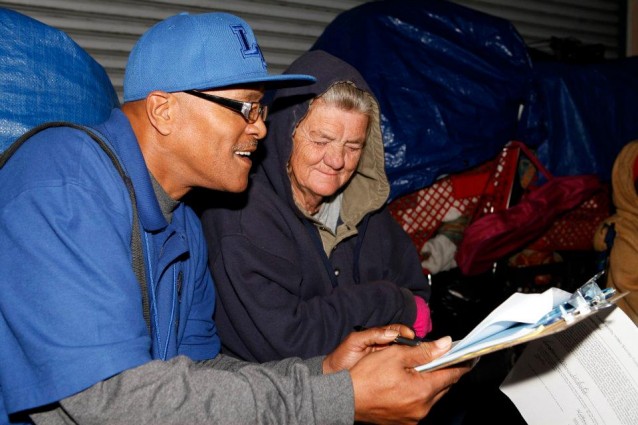
The 100,000 Homes Campaign was founded with a deliberately lofty goal: get 100,000 homeless people off the streets within four years.
What’s more, the organization wasn’t focused on homeless people who were most likely to get themselves off the street. Rather, 100,000 Homes worked with communities to target the people in the most dire need of help: those who were chronically homeless or who had severe medical conditions.
On Wednesday, just under four years after 100,000 Homes launched, the group surpassed its goal, helping communities secure housing for 101,628 homeless people as of press time. This figure includes 31,171 homeless veterans.
The announcement came at a press conference featuring former Army Private First Class Alvin Hill. Despite serving his country in the military, Hill fell on tough times and has endured homelessness for the past 20 years. In April, Hill became the 100,000th homeless person housed as A-SPAN, a local organization in Arlington, Virginia, helped secure him a permanent apartment.
This isn’t simply a humanitarian achievement, but a financial one as well. Doing nothing about homelessness is extraordinarily expensive. As a result, 100,000 Homes estimates that the nationwide effort to house 100,000 homeless people will save taxpayers $1.3 billion annually.
100,000 Homes, a project of the Community Solutions non-profit organization, doesn’t house homeless people itself. Instead, its 13 staffers work with local community groups ranging from housing authorities to the Veterans Administration to improve the way they’re tackling homelessness. The campaign’s partners ranged from large metropolitan cities like New Orleans and Phoenix to smaller areas like Omaha and the state of West Virginia.
It encountered many problems in the beginning. Some cities had plenty of low-income housing capacity but didn’t have a system set up to connect with its neediest residents. Other communities knew they had significant homeless populations but didn’t have a sense of which people it should help first. And few, if any, were taking an analytic, metrics-based approach to solving homelessness.
“The key contribution 100,000 Homes was able to make was coordinating all the various groups in a community working on solving chronic homelessness,” Jake Maguire, Communications Director for 100,000 Homes, told ThinkProgress.
When a city contacted 100,000 Homes for consultation — which it provided free of charge — the first thing the campaign would advise was to enlist as many volunteers as possible to walk the streets at night and do a community-wide homeless census. The purpose of this was two-fold. First, the city gained valuable data on who it was seeking to help, enabling it to triage the situation and help the most vulnerable people first. Second, the massive volunteer effort rallied the community around the problem of solving chronic homelessness.
“People all of a sudden become invested,” Maguire said. “They learn the names and stories of people who could die on the street. This helps create a groundswell of political support for housing.”
The results have been stunning, and not just the more than 100,000 of the most vulnerable homeless people in the country who have been given housing. Two partner communities — Phoenix and Salt Lake City — have already eliminated chronic homelessness among veterans; 57 communities in total are now on track to end chronic homelessness in the next three years. Moreover, the effort is sticking. 100,000 Homes analyzed its housing data and found that after one year, 85 percent of homeless people it had helped put in housing were still off the streets. And the average wait time to get a homeless person off the streets has been reduced from 340 days to as little as two weeks in some communities.
What will happen to 100,000 Homes now that its namesake goal has been achieved?

